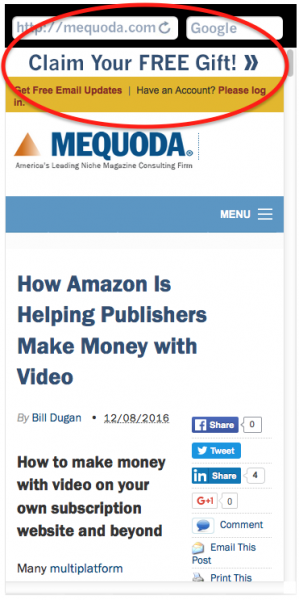
The most important SEO tip of the month is suppressing floaters and OFIEs for mobile phone users
By now most of you know that Google has decreed popups and interstitial ads, which include Mequoda Best Practice floaters, to be outlawed on mobile phones as of tomorrow, January 10, 2017.
Google objects to the way these ads interfere with user experience by blocking content, and certainly most people claim they find them annoying, especially on a mobile device where the floater ads can cover nearly all the content.
Of course, Mequoda’s data has always shown that floaters for free products are beneficial for boosting Email Capture Rate (ECR), and in fact, we tested a suppression of the mobile floater for a client this fall and saw a 22% drop in the ECR.
[text_ad]
Clearly, this is a cause for concern, but at the same time, Google has promised to punish websites that use these popups by dropping them down in search rankings, so we can’t ignore this.
We’ve recommended to our clients that they discontinue using full-screen floaters on mobile sites. In an extra-precautionary step, we also recommend suppressing all OFIEs on mobile, as Google said in their official blog post that they intend to penalize sites “using a layout where the above-the-fold portion of the page appears similar to a standalone interstitial, but the original content has been inlined underneath the fold.”
What’s a floater? It’s named a floater because it appears to float onto a webpage. This was a method created in order to fight back against pop-up blockers. While it may look like a pop-up, a floater does not open in a separate window and therefore cannot be blocked or banned. The floater order form is a tactic for increasing landing page conversion rates and may be used at nearly every entry point on a website, though it’s usually better to set a cookie to let the floater appear to the user only once upon entry to the site. Read more about floaters to see what they look like.
What’s an OFIE? An OFIE is an order form tucked at the top, bottom or in the middle of your editorial, and sometimes your advertorial and promotional content. We’ve had a few best practice versions over the years, but they all do the same thing: collect an email address. The OFIEs we are suggesting to suppress for mobile viewers is the one that is typically placed above content. Read our article on OFIEs to see what they look like.
So, no more floaters and no more OFIEs on mobile… is there anything we can do to collect email addresses from visitors using mobile devices?
Yes! Because we’ve seen an unhealthy drop in conversions by simply suppressing the floaters (as referenced in the client case study above), we are also recommending that you switch to a “pencil” or “ribbon” floater. These narrow floaters, by pinning themselves to the top or bottom of a mobile screen, don’t interfere with the user experience and meet Google’s criteria for acceptable advertising.
The simplest deployment for this small ad would read something like “Claim Your FREE Gift!” across all zones, and clicking on it would lead the user to the appropriate Rapid Conversion Landing Page (RCLP), just as our floaters do now. Because the Mequoda Method relies heavily on free reports that are tightly aligned with the content the user has sought out, we recommend having a ribbon floater created and deployed for each category on your website.
Here is an an example of Mequoda’s ribbon floater:
SEO tip: Rolling out new ribbon floaters on your mobile site
We suggest suppressing your floaters and OFIEs and deploying this new ribbon/pencil floater, which again we believe will prove a better option than simply deleting your existing mobile conversion architecture.
As results for the new ribbon/pencil mobile floater become available, we will share them here on the Mequoda Daily. We feel this limited message format of “Claim Your FREE Gift!” is ripe for offer testing on a recommended four-week rotation.
And as far as Google goes, for now, these changes only affect mobile phones, not tablets (where floaters or interstitials don’t completely cover the displayed content).
How are you working with Google to comply with their new mobile-friendly guidelines?



